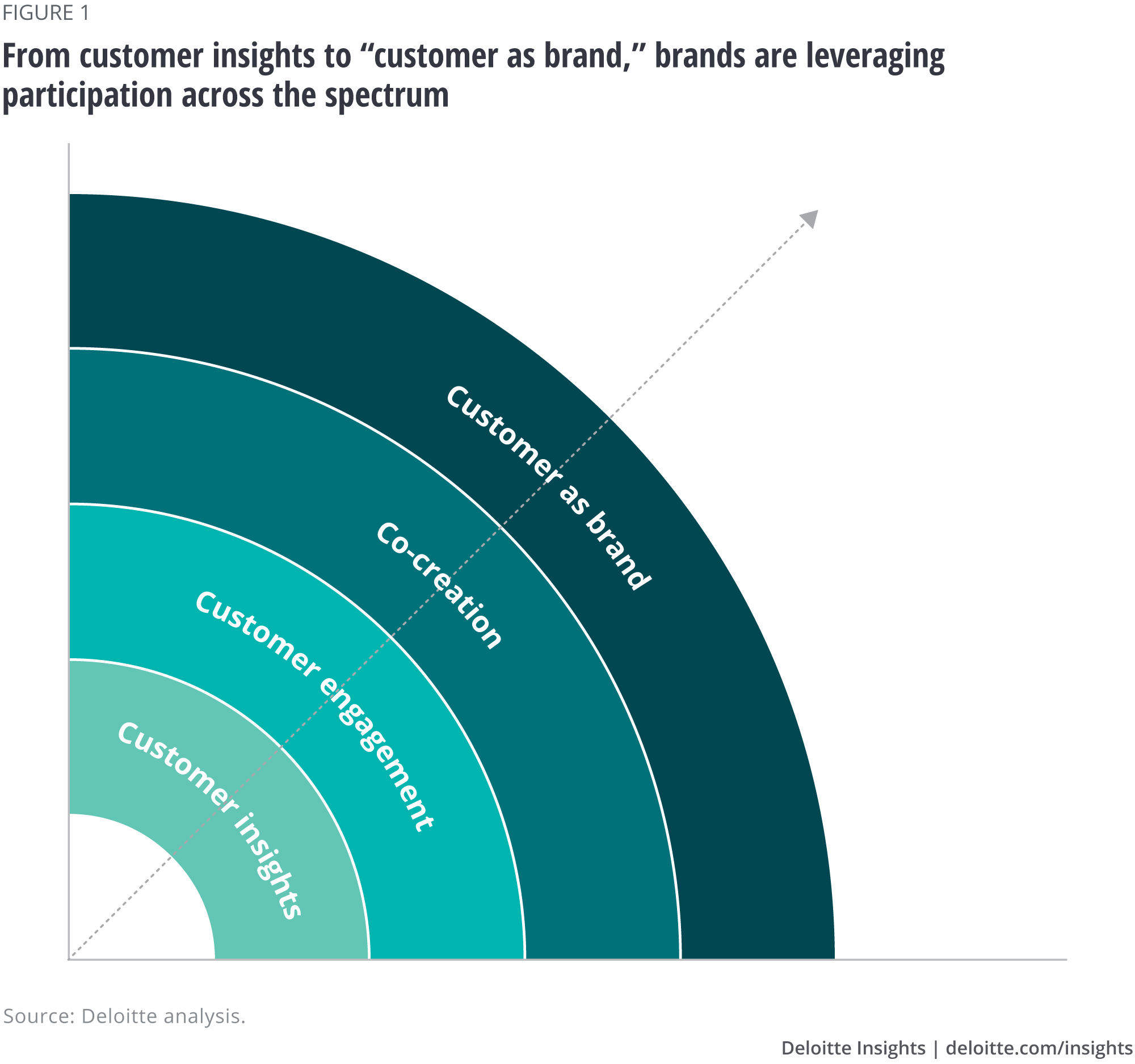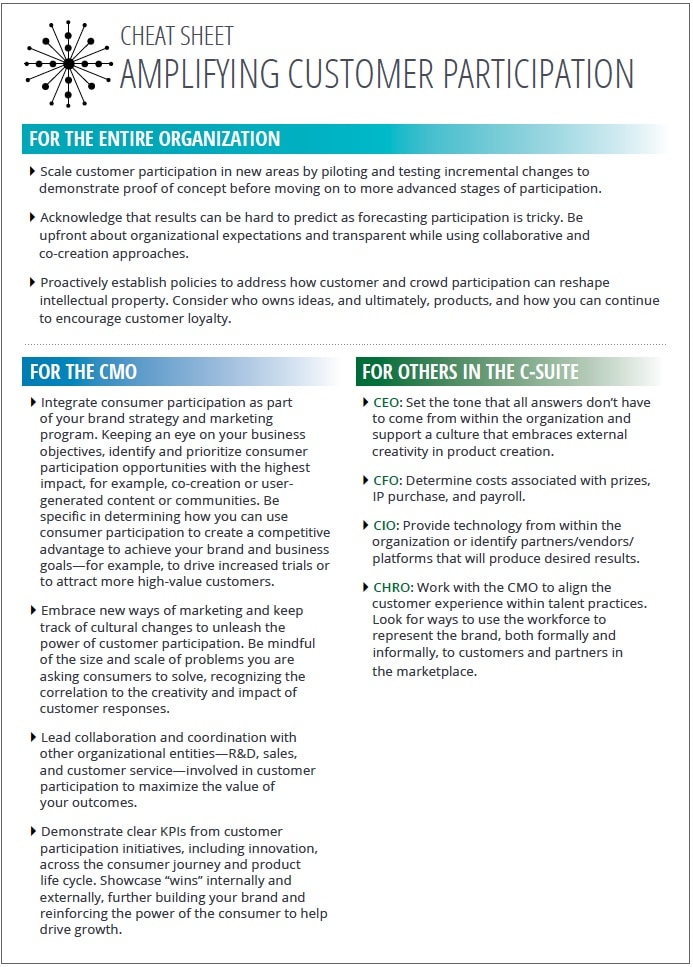
The amplification of consumer participation How emerging customer engagement strategies are unlocking new value for global brands
10 minute read
15 October 2019
 Diana O'Brien ארצות הברית
Diana O'Brien ארצות הברית Andy Main ארצות הברית
Andy Main ארצות הברית Suzanne Kounkel ארצות הברית
Suzanne Kounkel ארצות הברית Anthony R. Stephan ארצות הברית
Anthony R. Stephan ארצות הברית
Increased customer interaction builds competitive advantage and strengthens loyalty. Discover ways in which consumers can generate value across the entire product and customer life cycles.
Imagine it’s 1870. You are an entrepreneur running a fledgling dry goods business in San Francisco. Based on a conversation with a tool retailer, you sense an opportunity to develop a new product. What do you do next? At this point in history, startups and existing enterprises alike were limited to “word of mouth” participation—to both learn from customers about existing products and services and to inform the design of something new. Businesses could gain insights only through direct interactions with customers. Using this approach, the San Francisco entrepreneur in question learned of the limited availability of durable pants for workmen in the market. In 1873, based on these findings, Levi Strauss & Co. obtained the first US patent to develop the original pair of men’s blue jeans.1
Learn more
Explore 2020 Global Marketing Trends
Download the full report or create a custom PDF
Explore the Marketing & sales collection
Subscribe to receive related content from Deloitte Insights
Download the Deloitte Insights and Dow Jones app
This “word of mouth,” which helped develop the Levi’s brand as well as product innovations such as blue jeans, has historically emerged through customer participation. In today’s marketplace, participation is at a high, transforming the entire role of marketers and how they work (see our agility trend for more information).The amplification of global participation through technology provides new opportunities for consumers, citizens, and communities to engage directly in shaping, influencing, building, and co-creating platforms, initiatives, movements, and brands. The extended reach offered by digital access, and a greater willingness from consumers to play the role of marketer, has helped empower both startups and established brands to orient elements of their business around opportunities to create new products and services and encourage consumers to participate in the process.
While going out to the local hardware store to engage with customers remains a tried and tested marketing strategy, it is likely no longer sufficient to ensure customer participation. Many brands and marketers have recognized that to keep up with the competition, they need to evolve their approach and create a dynamic two-way engagement across all stages of the consumer journey and the product life cycle. Those doing it best are often seeing willing customer participants become brand ambassadors, influencers, advocates, collaborators, and even innovators, representing and driving brand participation across the marketplace. As Adam Petrick, global director of brand and marketing at Puma, explains, engaging consumers is paramount for global brands: “Our brand is out there in the public space; it’s been consumed by people all around the world, and ultimately, they are the ones that shape it.”2
In this article on the global marketing trend of participation, we present an inside look at how companies, led by marketing, are shifting their strategies to leverage the power of the consumer. We discuss tactics that brands can deploy at each stage of the customer journey and product life cycle and offer insights on the methods they’re adopting to amplify customer participation.
Where are brands getting consumers to participate?
Engaging consumers across their entire journey and the product life cycle can enable companies to harvest insights and leverage customer experience, influence, voice, and sentiments to drive development and accelerate growth—from trial to loyalty. Participation is all about unleashing the power of the consumer as the brand advocate, with consumers becoming the brand “media.” From big brands building “design-and-test” crowdfunding campaigns to co-creating products with new technologies such as virtual reality (VR) and 3D printing, our research reveals the common levers many brands are pulling to engage and build around customer participation. Accordingly, we developed five thematic areas in which brands are helping drive participation today:
- Virtual truthing. Online platforms such as Remesh3 and dscout4 tap directly into customers and crowds, enabling brands to engage consumers quickly and effectively to gain insights about emerging products and services in nearly real time. For instance, dscout functions as a live video diary, charting how individuals engage with products and services, delivering rich, in-depth insights for a brand. Remesh offers various ground-truthing models. Driven by artificial intelligence (AI) and analytics capabilities, Remesh can be harnessed at “any stage of the customer life cycle” to learn about improving the customer experience.
- Crowdfunding. Crowdfunding campaigns have been around for the better part of the past decade, helping launch startups and fundraise for new products. By voting with their contributions, individuals can support new ventures, charities, and events that matter to them. In a new wave, bigger brands are leveraging crowdfunding to gain access to consumer insights at different stages of the product life cycle. Customers purchase prototypes, enabling brands to gain critical insights early in the process to support R&D and develop the most creative, demand-driven products. For example, in 2018, Gillette launched its “heated razor” concept to gauge early-stage customer interest through the crowdfunding platform, IndieGogo. The crowd informed the design and helped move the razor into production, purchasing the allotted 1,200 razors within a matter of weeks.5
- Customization. Many leading brands are seeking ways to involve the customer directly in customizing designs of new, emerging products. Platforms such as Betabrand allow custom designers and producers to receive early-stage inputs from consumers, who function as co-creators in supporting prototypes.6 Such platforms help motivated designers gain access to customers and build a following, while customers can show off their skills as “early adopters.” Timberland, for example, is testing new approaches to involve its customers in shaping new designs for boots, while also building loyalty before these designs hit the market.7
- Collaboration. Collaborative participation helps integrate customers in different phases of the product life cycle, often enlisting their support in co-creating products, solutions, and services directly with brands. LEGO, for instance, pioneered collaborative, user-created innovations, allowing its vast network of global user groups to directly engage in co-creating their own LEGO creations.8 Mindsumo is a collaborative platform that helps brands engage customers in collaborations on innovations, while also offering a platform for crowdsourced prize challenges.9 Ferrero, one of the largest chocolate producers and confectionery companies in the world, engaged its consumers on Mindsumo by asking: “What’s your Ferrero Rocher packaging design for Christmas or Valentine’s?”10 Through this question, the company engaged interested customers to share their inputs, doling out cash awards for the best ideas. Other examples of collaboration include personalizing, designing, and 3D printing a new pair of Adidas shoes right in the store.11
- Communities. Communities are taking shape around specific brands to inform, support, and offer creative advice on how their products can be used. Communities pop up on social sites such as Reddit and Facebook to help brand loyalists and newbies solve problems and experiment with new uses for products. For example, Instant Pot, a pressure cooker, has an active superfan Facebook group that enables people to share recipes and connect while the company gains deeper insights about how customers are using its products.12 Similarly, Made Unboxed, a furniture retailer in the UK, engages its customers through a dedicated social platform—Instagram—on its website. Followers can upload personal photos on Instagram showing how they’ve integrated Made Unboxed furniture into personal spaces, while fellow enthusiasts can “like” the photo and offer inputs on how to improve the décor. The company’s customers, thereby, function as both service providers and educators, advising other customers on product uses and helping troubleshoot issues with furniture.
Modeling brand participation: Play the spectrum
As with all other global marketing trends, participation is diffusing in unique ways across brands. To succeed, brands looking to build more effective participation strategies should evolve along with their customers. Traditionally, marketers focus upstream in the funnel, with the objective of driving awareness (of products and services) from consideration to trial. This likely won’t work anymore, as opportunities to market to customers across the marketing funnel and customer journey, focusing on the end-to-end experience, have emerged. While integrating customers into every aspect of the customer life cycle may not be necessary for every brand, those leveraging participation are aspiring toward the same outcome—integrating customer voice, experience, and influence to directly shape and inform how they deliver value to customers to accelerate growth, from trial to loyalty.
In figure 1, we present a visual spectrum representing the stages brands follow to leverage customer participation for their businesses, followed by a description of each stage. From baseline customer insights to full-blown co-creation and the “customer as brand” model, each approach is unique to the individual goals of the brand.

- Customer insights. In some businesses, insights might be all you need to understand your customers. In such cases, brands can deploy this baseline customer participation strategy that includes collecting and harvesting customer insights. Brands can leverage data from “likes,” website click-throughs, and customers interfacing with products and services to inform current and future product development. This model has low investment needs and simply requires data collection platforms, so companies can collect inputs and integrate customer perspectives into product development. Guinness’s Open Gate Brewery in Dublin, the “secret” brewery previously off-limits for the public and even employees (save a few select brewmasters), now invites people inside to taste new experimental beers.13 Mark Sandys, global head of beer, Baileys, and Smirnoff, explains, “It’s like beta testing …if there are beers that are really popular in the Open Gate Brewery, we’ll then take them out into a few pubs in Dublin and if they work there, then we’ll have the confidence that we can go and really launch them in a really big way.”14 In many cases, customer insights harvesting is the first stage of the journey toward more embedded customer participation.
- Customer engagement. The next level of engagement is focused on customer advocacy and influence, where customers represent brands in the marketplace as influencers and ambassadors, directly providing user-generated content in many cases. In this model, customers engage on behalf of the brand to inform and support other users at various stages of the product life cycle. Take the example of furniture retailer, IKEA, which has long experimented with novel ways of engaging its customers. Recently, IKEA revamped its mobile app and shopping portal IKEA Place to include an augmented reality function that enables customers to experiment with designs and share how they could transform a space—be it the home, office, school, or studio. From sofas and armchairs to coffee tables, all products in IKEA Place are 3D and true to scale. It allows customers to experiment with placement and share an image or video of what they bought with other shoppers and with IKEA, informing future purchases and product offerings for IKEA.15
- Co-creation. In co-creation, brands build customer participation directly into the product development life cycle. This model goes beyond sharing experience and insights. Companies are leveraging crowdfunding approaches, prototyping, and collaborative platforms such as Mindsumo to integrate customer insights, voice, and influence into different product design and development stages. Initially, this was limited to downstream production, but brands are increasingly moving participation up the value chain. LEGO’s “My Own Creation,” for example, allows customers to build and create their own blocks.16 In other cases, we see co-creation pushing brands to configure the entire business model around customer participation. The videogame Minecraft is built around users interacting with each other, creating entire worlds for players to engage.17 Transport applications Waze and Moovit are built based on crowds populating maps and engaging through user-interaction in real time.18
- Customer as brand. At the highest end of the spectrum, brands are eliciting full-scale participation from customers, getting them to act as part of the brand. Airbnb is an example of how companies are building platforms around the customer, with users functioning dually in the role of both brand and consumer. In this model, customers wear other hats as well, acting as educators, trainers, and customer service providers. Another example is GiffGaff, a mobile service provider in the UK that crowdsources several aspects of its business, including customer support, recruitment, and product development. Customer queries about the mobile service are answered directly by other customers in an online community.19 In many cases, community platforms provide the stage for customers to act as the brand. For example, China’s “Little Red Book,” a social e-commerce platform, facilitates buyers to engage in a dynamic world of overlapping customers, product owners, and influencers. Buyers and key opinion leaders (KOL) offer advice on products that are shared across the community, comprising more than 17 million female users. Brands leveraging the platform work to manage their reputation in near real time, ensuring positive content flow from influencers while responding in the moment to any complaints from buyers.
Pave your own path to participation
Identifying how and in which areas to integrate customer participation in the consumer journey and the product life cycle can be overwhelming for marketing teams and the company at large. There is no right answer as each of these models is relevant and may work for you but should be tailored to your company’s strategy and business objectives. Reflecting on your brand and marketing strategy—who you are to your customers and how you can best leverage them across the customer journey/product life cycle—can set you on the right path to benefit from customer participation.

© 2021. See Terms of Use for more information.
Explore the collection
-
The amplification of consumer participation Article5 years ago
-
Purpose is everything Article5 years ago
-
Valuing your most important asset—talent Article5 years ago
-
Are you a trust buster or builder? Article5 years ago
-
2020 Global Marketing Trends Collection













